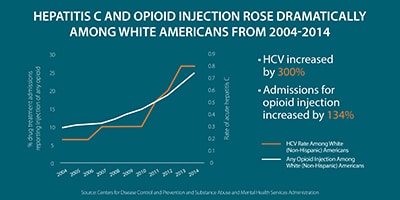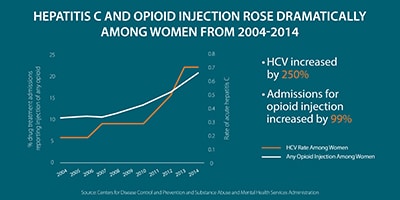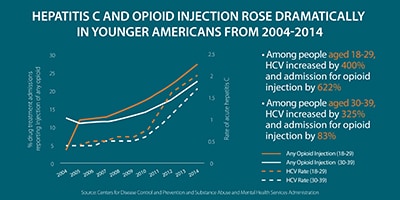
Increase in Hepatitis C Infections Linked to Worsening Opioid Crisis
Today, CDC published new research suggesting the recent steep increase in hepatitis C virus infection is associated with increases in opioid injection. Until the last decade, hepatitis C primarily affected older generations – mostly baby boomers, born between 1945 and 1965 – but as the opioid crisis has worsened, the virus has gained a foothold among younger people who inject drugs. The new report underscores the importance of an integrated response to these dual epidemics.
There have been substantial, simultaneous increases in cases of acute hepatitis C (133 percent) and admissions to substance use disorder treatment for opioid injection (93 percent) from 2004 to 2014. Increases were seen at the national level and when data were analyzed by state, by age, and by race and ethnicity, pointing to a close relationship between the two troubling trends. The most dramatic increases were seen among younger Americans. Among 18-to-29-year-olds, hepatitis C rates increased by 400 percent and admission for opioid injection by 622 percent. Among 30-to-39-year-olds, hepatitis C rates increased by 325 percent and admission for opioid injection by 83 percent.
For more information, please see our press release. Additional media resources including graphics can be found on the NCHHSTP online newsroom.
December 21, 2017 – Spike in new infections could have devastating long-term consequences
New CDC research suggests that the recent steep increase in cases of acute hepatitis C virus infection is associated with increases in opioid injection.
The study examines data from CDC’s hepatitis surveillance system and from the Substance Abuse and Mental Health Services Administration’s national database that tracks admissions to substance use disorder treatment facilities in all 50 states. Across the nation, researchers found substantial, simultaneous increases in acute hepatitis C (133 percent) and admissions for opioid injection (93 percent) from 2004 to 2014. These increases were seen at not only the national level, but also when data were analyzed by state, by age, and by race and ethnicity. Taken together, the findings point to a close relationship between the two troubling trends.

























.jpg)









No hay comentarios:
Publicar un comentario